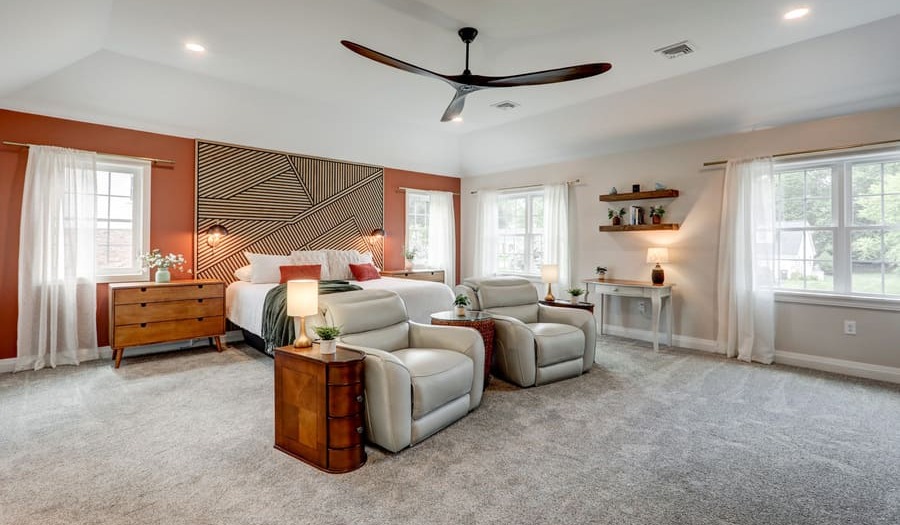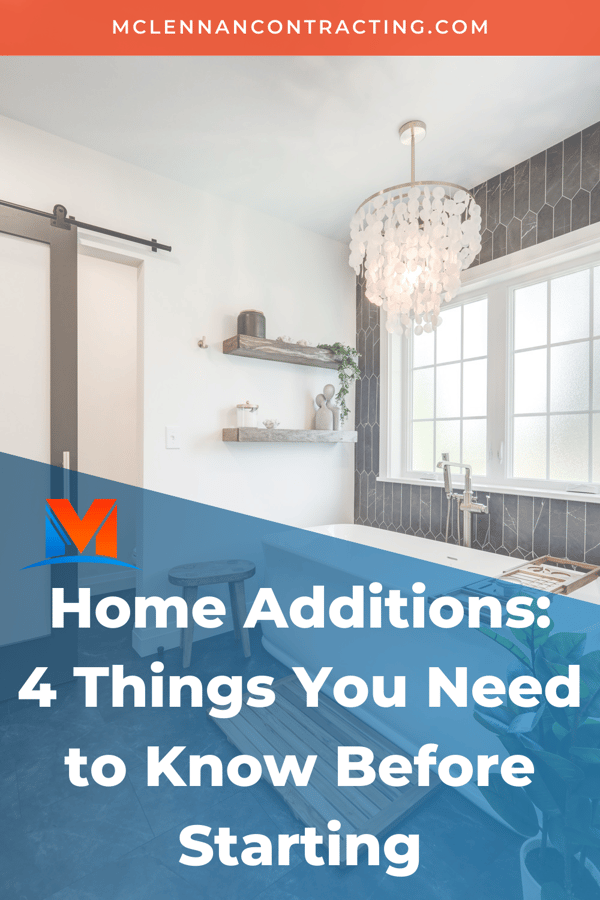6 min read
Lancaster Home Additions: 4 Things You Need to Know Before Starting
By: The McLennan Team | December 13, 2023

You love your neighborhood. Your commute is great and you’re zoned for amazing schools. Your neighbors are your friends. The home you live in now is the one you brought your newborn home to, or the one to which your adult children return for the holidays. You don’t want to move–but you’re starting to feel the pinch of a home that’s just too small. You could really use more space. Is a home addition the right move for you?
It just might be. An addition to your Lancaster home allows you to stay in the home you love while converting it into the home of your dreams. It’s often a wiser financial decision than moving or building, and it can usually be accomplished much faster. There are some important factors to consider when thinking about adding on to your home–read on for four things you need to know.
#1. Know the Most Common Types of Additions
Most home additions fall into one of four categories. Each type has benefits and drawbacks. What kind of addition is right for you and your home will depend on your goals, your existing home, what kind of space you’re looking to add, your neighborhood’s zoning laws, and more.
Adding On One or More Rooms
This is probably what most people think of when they picture a home addition: starting from scratch and adding a bedroom, a dining room, a bathroom, a family room, or even multiple rooms to the existing house. Bedrooms and bathrooms are the most common type of room to add on to a home, but a home office or more living space is popular as well.
Unless you’re sure this home is your forever home, try not to over-customize your addition too much. Keep potential resale in mind. Also, make sure you’re not adding too much value to your home with the addition of one (or many!) rooms. If your home is the most expensive one or largest one in your neighborhood, you likely won’t get the return on your investment that you’re looking for, if you decide to sell someday.
A Bump-Out
Also called a micro-addition, bumps outs are popular ways to add space while saving on cost. Bump-outs generally add two to fifteen square feet to an existing room–much more than that and they become a traditional addition. Because they are smaller, bump outs generally don’t require foundation work or much roofing work, which keeps the cost down. And if two to fifteen square feet seems small, keep in mind that it’s enough space to add a kitchen island and counter space in your kitchen, an extra bed in a bedroom, a mudroom, and more. It could definitely improve the flow and useability of your home.
A Sunroom or Four Seasons Room
Very popular types of Lancaster, PA home additions, sunrooms and four seasons rooms tend to be less expensive to build and give you a lot of space and enjoyment. Both types of rooms are generally bright and airy with lots of windows. Sunrooms traditionally aren’t connected to your home’s HVAC. This means that they don’t have heating or air conditioning, which is why they’re inexpensive to add on. Four seasons rooms are connected to the HVAC and so are more comfortable to use all year.
A Garage Conversion
Another very popular home addition is the conversion of a garage into living space. Because a garage already has a foundation, ceiling, and three walls, converting it is a fairly quick and easy way to gain a lot of space. You can turn your garage into a playroom, game room, exercise space, office, or mother-in-law suite. While you won’t be doing a lot of the work you’d need in a traditional addition, you will have to have plumbing, insulation, and flooring installed. Another popular option is to add a room on top of your garage–it can often be a great location for an additional bedroom, even a master suite.
#2. Know if You Should Build Up or Out
Building up refers to adding on to your home vertically–adding a second or third story or putting a bedroom over the garage for example. It means building onto your existing home. Building out means adding square footage on the ground level, thus increasing your home’s footprint. They both have pros and cons and which is best for you depends on a variety of factors.
Building Up
- If you’re adding a bedroom or bathroom, building up is a good option, since those are rooms that are often on the upper floor.
- Building up is usually cheaper since you don’t have to do groundwork or a foundation.
- Your contractor will be able to tell you if your home’s structure and foundation can support a second story.
- You will usually need to move out of your home when building up. If you don’t have people you can stay with, factor the cost of lodging into your budget.
- The size of your Lancaster home addition will be determined by your home’s original footprint when you build up. This may mean, for a smaller home, that you won’t get the square footage you want.
Building Out
- This is the best option when the rooms you’re adding on need to be on the ground floor–a new kitchen or living room for example.
- You can often stay in your home when building out. You’ll have to put up with the noise and dust, but since your contractor can get a lot of the work done before he opens up the wall that connects the original part of the house to the new part, the disruption won’t be as bad.
- Zoning laws and the size and placement of your home will impact how large your addition can be.
- You often have more flexibility in terms of size, room placement, and design when you build out.
#3. Know What Costs to Expect
As is the case with any type of home remodel or renovation, it’s hard to give averages when it comes to home additions. There are so many factors at play:
- The size of the addition
- The location of the addition (Over the garage? On the ground floor?)
- What type of room you want to add on (bathrooms and kitchens need to include plumbing, but bedrooms don’t)
- What finishes you choose
- The exterior finishes needed
- And so much more.
But we do have some tools that can give you an idea of what costs you’re looking at. We’ve created the Lancaster Home Remodeling Cost Guide to help you plan for your addition. You can check out this blog post about the costs of Lancaster home remodels. And you can schedule a call with one of our project consultants to help you get a handle on what costs to expect.
In general, for a primary suite addition (which includes a master bedroom, full bath, and closet) in our area, you can expect to pay between $167,000 and $347,000 (according to the Cost vs Value data for the Middle Atlantic Region). For the addition of a bathroom, you might pay somewhere between $59,000 and $109,000. Again, these prices can vary.
Will you get a good return on your investment? While the ROI for home additions isn’t as high as it is for other renovation projects, it does still increase the value of your home. And especially if you plan to live in your home for a few years or more, an addition will absolutely increase your enjoyment of it.
#4. Know Where to Find Help
Building an addition onto your home–maybe even more than remodeling an existing space–comes with so many decisions that need to be made. Because you can add on in so many different ways, building up or out, adding a whole room or several rooms, designing a bump-out or a master over the garage, it can be overwhelming to know where to start. We’re here to help. Our team of designers and consultants can help you discern the best ways to meet your goals for your home. Our design-build process means that we handle all steps of the addition process in-house, so there’s never a breakdown in communication between you, our designers, and our contractors. It ensures that you get the best possible experience and the most outstanding finished project possible.
We at McLennan Contracting genuinely care about you, your family, and your home. We want to partner with you to make your home a haven, a retreat, and the best place it can be for you and the ones you love. Contact us today and let’s get started.

Written by The McLennan Team
The McLennan Team is a group of experienced professionals dedicated to delivering high-quality remodeling solutions. With a passion for transforming spaces and improving lives, our team combines expert knowledge with a personalized approach to meet the unique needs of each client. We believe in 'life improvement through home improvement,' and our goal is to guide you through every step of the remodeling process, ensuring a seamless experience and results that enhance your home and lifestyle.

